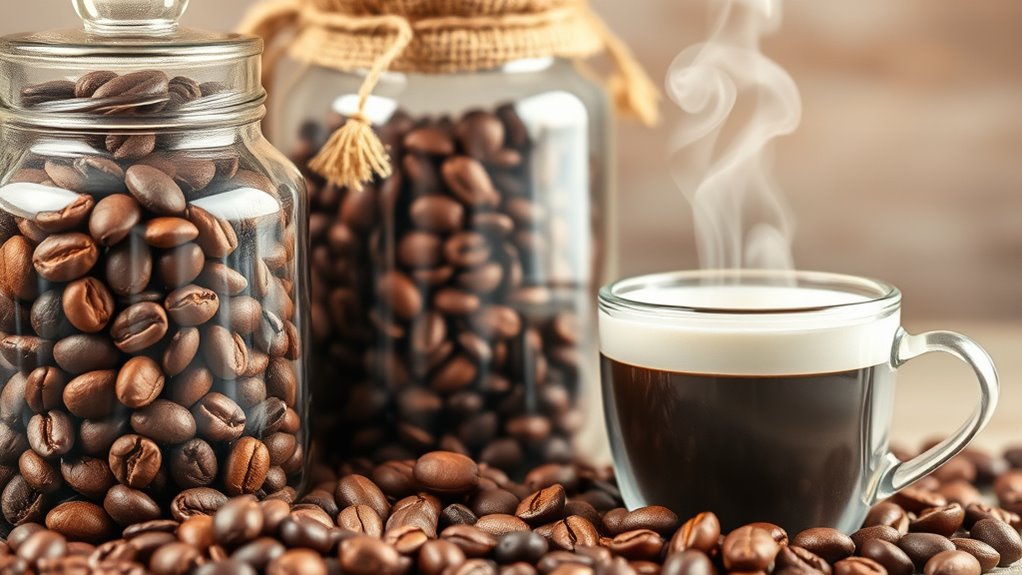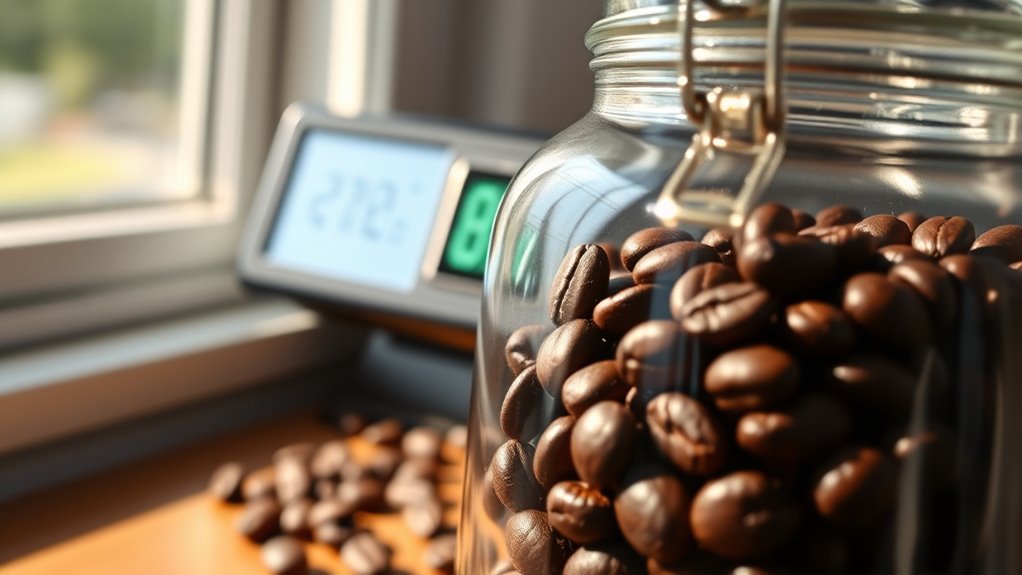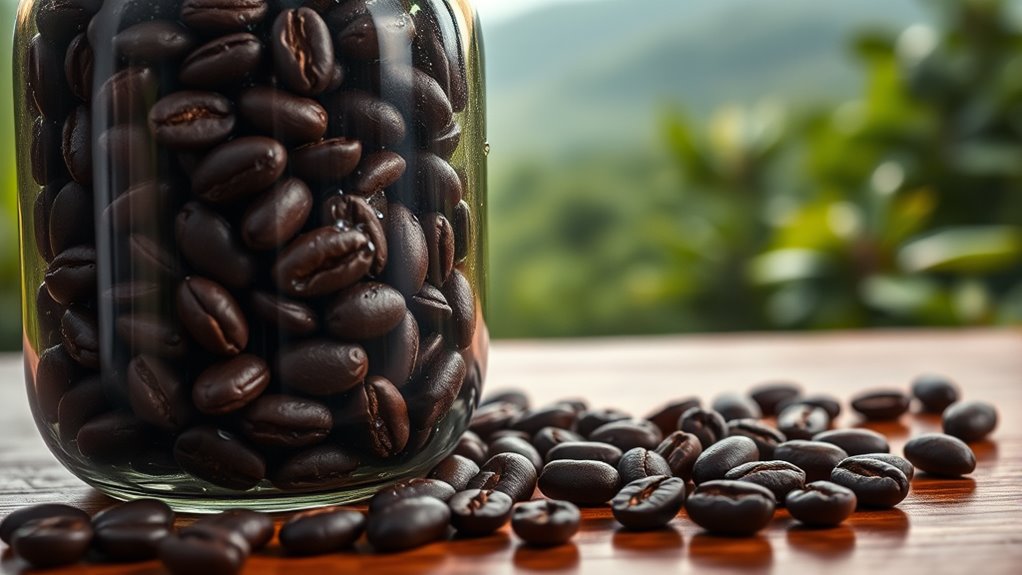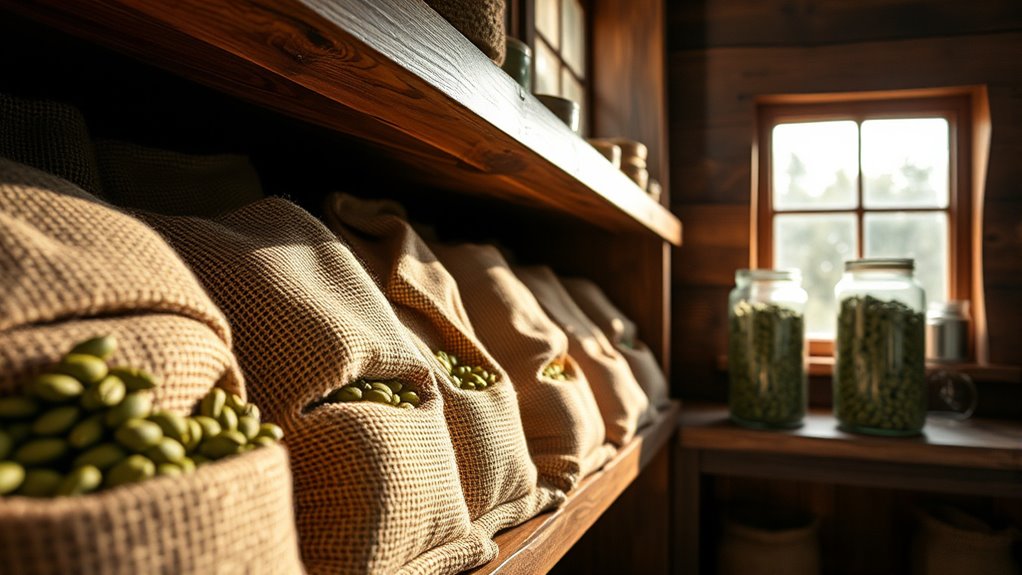Coffee storage directly impacts its quality. High humidity can cause mold and spoilage, while too little moisture can dry out the beans, both leading to flavor loss. Ideal conditions include stable temperatures between 15°C to 25°C and humidity around 50% to 60%. Using airtight containers and avoiding light will help preserve freshness. With the right strategies in place, you can greatly enhance your coffee’s flavor profile. Discover more about the best practices for storage ahead.
Key Takeaways
- Proper humidity levels between 50% and 60% prevent mold growth and maintain flavor integrity in coffee storage.
- Oxygen exposure leads to oxidation, causing off-flavors; hermetic packaging minimizes this risk.
- Green coffee beans should be stored at 15°C to 20°C (59°F to 68°F) to prevent flavor degradation.
- Roasted coffee should be kept between 20°C and 25°C (68°F to 77°F) to avoid oxidation and maintain freshness.
- Airtight, opaque containers protect coffee from air, light, and moisture, preserving its quality over time.
Key Factors Influencing Coffee Quality During Storage

When it comes to storing coffee, understanding key factors that influence its quality can make all the difference. One vital element is moisture content. High humidity levels above 60% can lead to mold growth, ruining your coffee’s flavor. For ideal storage, aim for humidity between 50% and 60%.
Oxygen exposure is another enemy; it causes oxidation, leading to off-flavors and a flat taste. To combat this, use hermetic packaging, which keeps both moisture and oxygen at bay, preserving the freshness of your coffee.
If you’re storing green beans, remember that proper packaging in a non-AC environment can help maintain quality over time. This approach reduces costs and environmental impact while ensuring you enjoy the best flavor from your coffee.
The Role of Temperature in Coffee Preservation

Understanding how temperature affects coffee preservation is just as important as managing humidity and oxygen levels. The right temperature can greatly impact your coffee’s quality and flavor profile.
Here are three key points to keep in mind:
- Optimal Range: Store green coffee beans between 15°C and 20°C (59°F to 68°F) to prevent chemical reactions that degrade flavors.
- Roasted Beans: Maintaining a stable temperature of 20°C to 25°C (68°F to 77°F) for roasted coffee is essential to avoid flavor loss and oxidation.
- Avoid Fluctuations: Temperature changes can cause condensation, introducing moisture that ruins coffee quality and accelerates the loss of freshness.
The Impact of Humidity on Coffee Freshness

Humidity plays an essential role in maintaining the freshness of coffee, as excessive moisture can lead to serious quality issues. When humidity levels exceed 65%, coffee beans absorb moisture, creating a breeding ground for mold and spoilage. This drastically impacts the quality of green coffee, considerably diminishing its flavor and aroma. To preserve flavor integrity, aim for a storage humidity between 50% and 60%. Keep in mind that high humidity can result in an average loss of 1.4 points in taste score, with premium coffees suffering even more.
| Humidity Level | Effect on Quality | Recommended Range |
|---|---|---|
| Above 65% | Mold growth, spoilage | Not recommended |
| 50% – 60% | Maintains flavor integrity | Ideal |
| Below 10% | Drying, loss of flavor | Not recommended |
Effective Storage Strategies for Green Coffee Beans

To keep your green coffee beans fresh and flavorful, employing effective storage strategies is essential.
Here are three key methods to enhance the cup quality of your specialty coffee beans:
- Use Airtight Containers: Store your green beans in hermetic or vacuum-sealed bags to control humidity and prevent oxidation, ensuring they stay fresh longer.
- Maintain Cool Temperatures: Keep your storage environment between 15°C and 20°C (59°F to 68°F) to minimize chemical reactions that can degrade quality.
- Monitor Conditions: Utilize digital monitoring systems to track temperature and humidity levels, allowing for timely adjustments to maintain ideal conditions for your green coffee beans.
Best Practices for Maintaining Roasted Coffee Quality

After you’ve taken the time to properly store your green coffee beans, the next step is ensuring your roasted coffee maintains its peak flavor.
Store roasted coffee in opaque, airtight containers to limit exposure to air, light, and moisture, which can greatly affect coffee quality. Ideally, consume whole bean coffee within two weeks to one month for maximum flavor retention.
Keep your storage temperature between 20 to 25 degrees Celsius (68 to 77 degrees Fahrenheit) to prevent condensation and spoilage. Avoid glass containers on kitchen counters, as light exposure can lead to a loss of flavor.
Consider hermetic packaging, like vacuum-sealed or nitrogen-flushed options, to slow oxidation and help preserve the freshness and aroma of your roasted coffee.
Frequently Asked Questions
What Are 3 Factors That Can Affect Quality of Coffee?
Three main factors that can affect the quality of your coffee are oxygen, temperature, and humidity.
When coffee beans come into contact with oxygen, they oxidize and can develop off-flavors. You’ll want to store your coffee in a cool environment, ideally between 20 to 25 degrees Celsius, to prevent spoilage.
Additionally, keeping humidity levels between 50% and 60% is essential, as high humidity can lead to mold growth and a loss of flavor.
Are Coffee Storage Containers Worth It?
Absolutely, coffee storage containers are worth it!
When you invest in airtight and opaque containers, you’re actively preserving your coffee’s flavor and aroma. These containers limit exposure to air, light, and moisture, which can ruin your brew.
Plus, using quality storage tools can keep your coffee fresh for longer, ensuring you enjoy every cup at its best.
Trust me, you’ll taste the difference when your coffee is stored properly!
What Are the Changes in Sensory Quality Characteristics of Coffee During Storage?
As time marches on, your coffee’s vibrant essence begins to fade like a once-bright sunset.
During storage, you’ll notice a gradual loss of acidity and freshness, leading to dull, musty flavors.
Humidity’s unwelcome embrace can further dull its charm, causing significant taste deterioration.
Oxidation, like a thief in the night, steals away the aromatic joys, leaving behind stale notes that can transform your beloved brew into a shadow of its former self.
Does Sealed Coffee Go Bad?
Sealed coffee doesn’t exactly go bad in the traditional sense, but it can lose its flavor over time.
Once you open the package, you’ll notice a decline in taste after about two weeks. Even sealed, coffee can develop stale or off-flavors if stored too long.
To enjoy the best quality, consume your coffee within a few weeks of roasting, and store it in a cool, dark place to help maintain its flavor.
Conclusion
To preserve your precious coffee, remember the three key elements: temperature, humidity, and proper storage. By keeping your beans cool, dry, and in airtight containers, you can maintain their magnificent flavors and aromas. So, whether you’re brewing bold blends or savoring single origins, safeguard your stash with smart strategies. Your daily cup deserves the best, and with a little effort, you can guarantee it stays fresh and fantastic from bean to brew!









